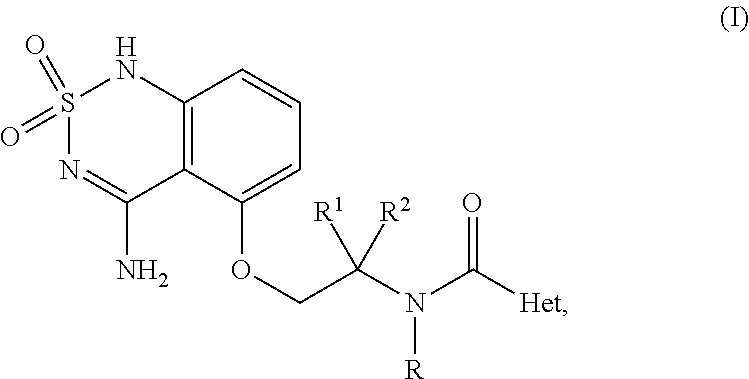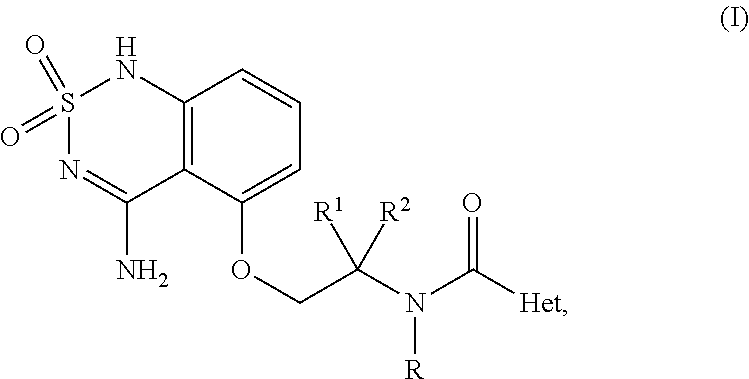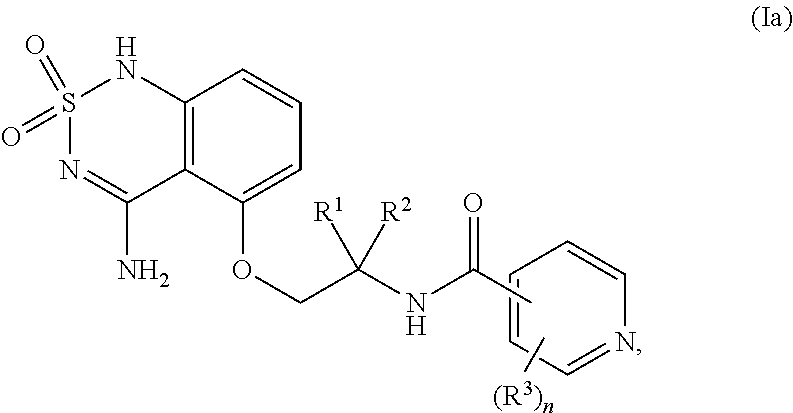Sweet flavor modifier
a technology of sweetener and modifier, which is applied in the field of sweet flavor modifier, can solve the problems of delayed onset and lingering, high intensity sweeteners such as sucralose and aspartame, and report sweetness delivery problems, and achieve the effect of increasing the sweet taste of an ingestible composition
- Summary
- Abstract
- Description
- Claims
- Application Information
AI Technical Summary
Benefits of technology
Problems solved by technology
Method used
Image
Examples
example 1a
1-((4-amino-2,2-dioxido-1H-benzo[c][1,2,6]thiadiazin-5-yl)oxy)-2-methylpropan-2-aminium chloride
[0118]
[0119]To a solution of tert-butyl(1-((4-amino-2,2-dioxido-1H-benzo[c][1,2,6]thiadiazin-5-yl)oxy)-2-methylpropan-2-yl-carbamate (114 g, 296 mmol) in ethanol (1 L), cooled to 0° C., was added HCl (4.0 M in dioxane, 370 mL, 1480 mmol). The mixture was stirred at 0° C. for 3 hours under nitrogen, and then allowed to warm to room temperature. The mixture was concentrated and the residue was suspended in diethyl ether (2 L) and refluxed for 1 hour. The mixture was cooled to room temperature and the solid was collected by vacuum filtration and dried under high vacuum to afford 1-((4-amino-2,2-dioxido-1H-benzo[c][1,2,6]thiadiazin-5-yl)oxy)-2-methylpropan-2-aminium chloride as a white solid (94 g, 100%). 1H NMR (DMSO-d6), 400 MHz: δ 1.37 (s, 6H), 4.12 (s, 2H), 6.70 (d, J=8.0 Hz, 1H), 6.85 (d, J=8.0 Hz, 1H), 7.48 (t, J=8.0 Hz, 1H), 7.65 (s, 1H), 8.43 (br s, 3H), 10.9 (br s, 1H). MS 285 (MH+)....
example 1b
Tert-butyl(1-((4-amino-2,2-dioxido-1H-benzo[c][1,2,6]thiadiazin-5-yl)oxy)-2-methylpropan-2-yl-carbamate
[0120]To a solution of tert-butyl (1-2-cyano-3-(sulfamoylamino)penoxy)-2-methylpropan-2-yl)carbamate (189 g, 492 mmol) in ethanol (1.5 L) was added solid NaOH (74 g, 1968 mmol), and the reaction was stirred at 115° C. for 13 hours under nitrogen. Upon completion, the mixture was cooled to 0° C. and neutralized with acetic acid. The precipitate was collected by vacuum filtration and dried under high vacuum to afford tert-butyl(1-((4-amino-2,2-dioxido-1H-benzo[c][1,2,6]thiadiazin-5-yl)oxy)-2-methylpropan-2-yl-carbamate as a white solid (114 g, 61%). 1H NMR (DMSO-d6), 400 MHz: δ 1.27 (s, 6H), 1.34 (s, 9H), 4.16 (s, 2H), 6.55 (d, J=8.0 Hz, 1H), 6.63 (d, J=8.0 Hz, 1H), 6.94 (br s, 1H), 7.37 (t, J=8.0 Hz, 1H), 7.75 (br s, 1H), 8.17 (br s, 1H), 10.8 (br s, 1H). MS 285 (MH+).
example 1c
Tert-butyl (1-2-cyano-3-(sulfamoylamino)penoxy)-2-methylpropan-2-yl)carbamate
[0121]To a solution of tert-butyl(1-(3-amino-2-cyanophenoxy)-2-methylpropan-2-yl)carbamate (150 g, 492 mmol) in THF (1.8 L) was added lutidine (86 mL, 738 mmol). The mixture was cooled to −45° C. and sulfamoyl chloride (71 g, 616 mmol), dissolved in dichloromethane (400 mL), was added. After 10 min, the reaction was warmed to room temperature and stirred for 2 hours. Upon completion, solid NaHCO3 (123 g, 1476 mmol) was added, and the mixture was stirred for 30 minutes, followed by concentration. The residue was diluted with ethyl acetate (1.8 L), washed with water (1 L), dried over anhydrous Na2SO4, filtered and concentrated in vacuo to provide tert-butyl (1-2-cyano-3-(sulfamoylamino)penoxy)-2-methylpropan-2-yl)carbamate as a clear oil, which was used immediately in the next step. MS 285 (MH+).
PUM
| Property | Measurement | Unit |
|---|---|---|
| temperature | aaaaa | aaaaa |
| temperature | aaaaa | aaaaa |
| temperature | aaaaa | aaaaa |
Abstract
Description
Claims
Application Information
 Login to View More
Login to View More - R&D
- Intellectual Property
- Life Sciences
- Materials
- Tech Scout
- Unparalleled Data Quality
- Higher Quality Content
- 60% Fewer Hallucinations
Browse by: Latest US Patents, China's latest patents, Technical Efficacy Thesaurus, Application Domain, Technology Topic, Popular Technical Reports.
© 2025 PatSnap. All rights reserved.Legal|Privacy policy|Modern Slavery Act Transparency Statement|Sitemap|About US| Contact US: help@patsnap.com



